Coburn J.W. Algebra and Trigonometry
Подождите немного. Документ загружается.

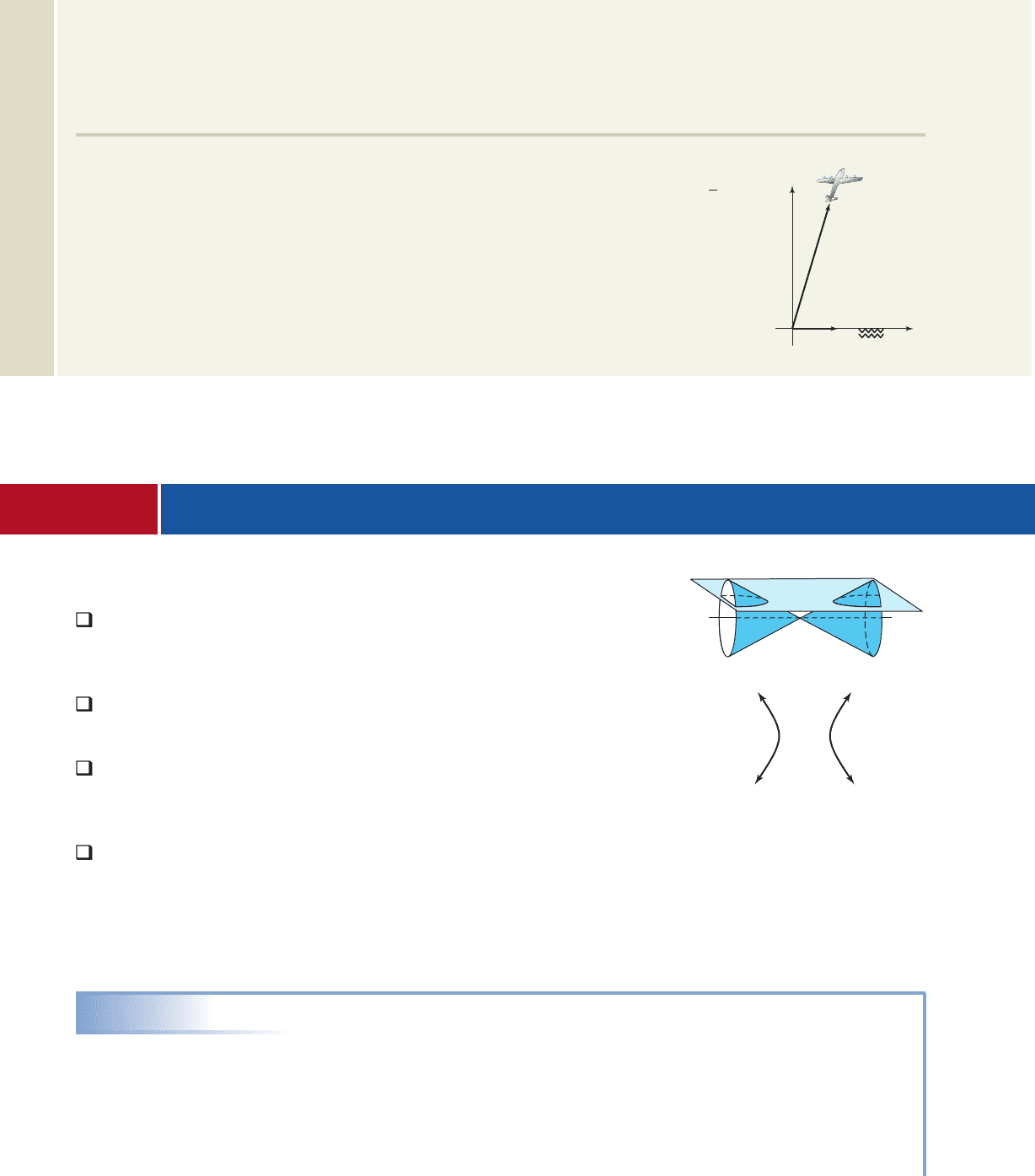
MAINTAINING YOUR SKILLS
82. (7.6) Use De Moivre’s
theorem to compute the
value of
83. (8.4) Find the true direction
and groundspeed of the
airplane shown, given the
direction and speed of the
wind (indicated in blue).
z 11 13
i2
6
.
940 CHAPTER 10 Analytic Geometry and the Conic Sections 10-22
80. (4.4) Evaluate the expression using the change-of-
base formula: log
3
20.
81. (3.8) The resistance R to current flow in an electrical
wire varies directly as the length L of the wire and
inversely as the square of its diameter d. (a) Write
the equation of variation; (b) find the constant of
variation if a wire 2 m long with diameter
m has a resistance of 240 ohms (); and
(c) find the resistance in a similar wire 3 m long
and 0.006 m in diameter.
d 0.005
College Algebra & Trignometry—
N
250 mph
heading 20
30 mph
heading 90
Exercise 83
10.3 The Hyperbola
As seen in Section 10.1 (see Figure 10.18), a
hyperbola is a conic section formed by a plane
that cuts both nappes of a right circular cone. A
hyperbola has two symmetric parts called
branches, which open in opposite directions.
Although the branches appear to resemble
parabolas, we will soon discover they are actu-
ally a very different curve.
A. The Equation of a Hyperbola
In Section 10.2, we noted that for the equation
if the equation is that of
a circle, if the equation represents an ellipse. Both cases contain a sum of
second-degree terms. Perhaps driven by curiosity, we might wonder what happens if
the equation has a difference of second-degree terms. Consider the equation
It appears the graph will be centered at (0, 0) since no shifts are
applied (h and k are both zero). Using the intercept method to graph this equation
reveals an entirely new curve, called a hyperbola.
EXAMPLE 1
Graphing a Central Hyperbola
Graph the equation using intercepts and additional points
as needed.
Solution
given
substitute 0 for x
simplify
divide by 16
y
2
9
16y
2
144
9 102
2
16y
2
144
9 x
2
16y
2
144
9x
2
16y
2
144
9x
2
16y
2
144.
A B,
A B,Ax
2
By
2
F,
Learning Objectives
In Section 10.3 you will learn how to:
A. Use the equation of a
hyperbola to graph
central and noncentral
hyperbolas
B. Distinguish between the
equations of a circle,
ellipse, and hyperbola
C. Locate the foci of a
hyperbola and use the
foci and other features
to write its equation
D. Solve applications
involving foci
Hyperbola
Axis
Figure 10.18
cob19529_ch10_0928-0940.qxd 12/6/08 12:44 AM Page 940 epg HD 049 :Desktop Folder:Satya 05/12/08:
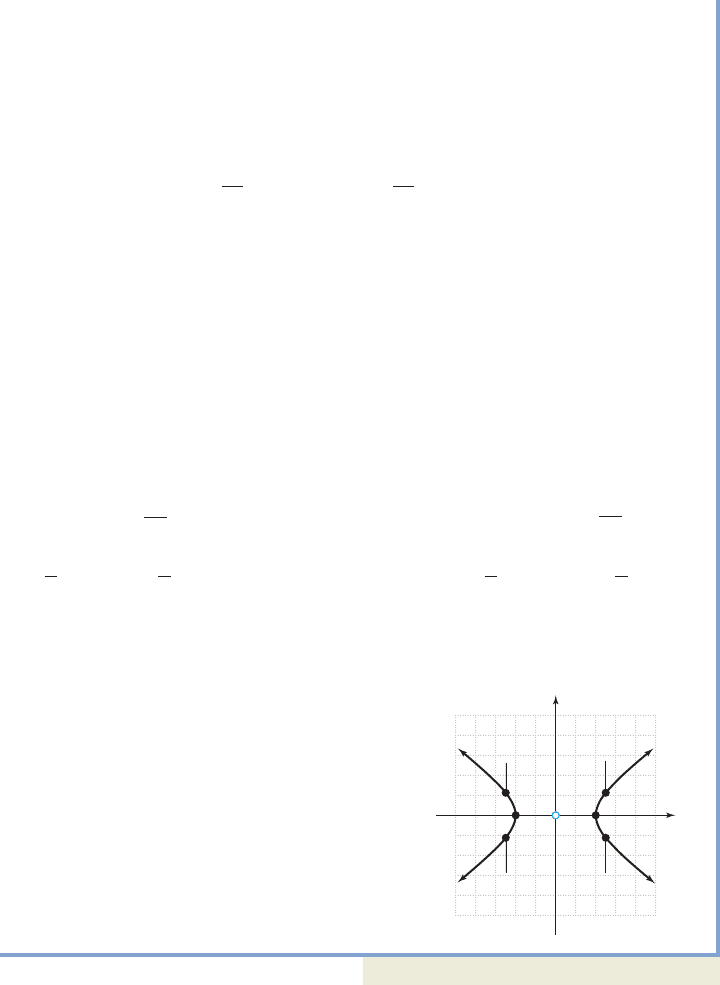
10-23 Section 10.3 The Hyperbola 941
Since y
2
can never be negative, we conclude that the graph has no y-intercepts.
Substituting to find the x-intercepts gives
given
substitute 0 for y
simplify
divide by 9
square root property
and simplify
(4, 0) and x-intercepts
Knowing the graph has no y-intercepts, we select inputs greater than 4 and less
than to help sketch the graph. Using and yields
given
substitute for x
simplify
subtract 225
divide by
square root property
decimal form
ordered pairs
Plotting these points and connecting them
with a smooth curve, while knowing there are no
y-intercepts, produces the graph in the figure.
The point at the origin (in blue) is not a part of
the graph, and is given only to indicate the
“center” of the hyperbola.
Now try Exercises 7 through 22
Since the hyperbola crosses a horizontal line of symmetry, it is referred to as a
horizontal hyperbola. The points and (4, 0) are called vertices, and the
center of the hyperbola is always the point halfway between them. If the center is
at the origin, we have a central hyperbola. The line passing through the center and
both vertices is called the transverse axis (vertices are always on the transverse
axis), and the line passing through the center and perpendicular to this axis is called
the conjugate axis (see Figure 10.19).
In Example 1, the coefficient of x
2
was positive and we were subtracting
16y
2
: . The result was a horizontal hyperbola. If the y
2
-term is9x
2
16y
2
144
14, 02
15, 2.252
15, 2.25215, 2.252
15, 2.252
y 2.25
y 2.25 y 2.25
y 2.25
y
9
4
y
9
4
y
9
4
y
9
4
y
2
81
16
16 y
2
81
16
16y
2
81
16y
2
81
225 16y
2
144
225 16y
2
144
9 1252 16y
2
144
5
2
152
2
25 9 1252 16y
2
144
9 152
2
16y
2
144
9 152
2
16y
2
144
9 x
2
16y
2
144
9 x
2
16y
2
144
x 5x 54
14, 02
x 4x 4
x 116
and
x 116
x
2
16
9 x
2
144
9 x
2
16102
2
144
9 x
2
16y
2
144
y 0
x
y
(0, 0)
(5, 2.25)
(5, 2.25)
(5, 2.25) (5, 2.25)
(4, 0) (4, 0)
Hyperbola
cob19529_ch10_0941-0953.qxd 12/6/08 12:45 AM Page 941 epg HD 049 :Desktop Folder:Satya 05/12/08:
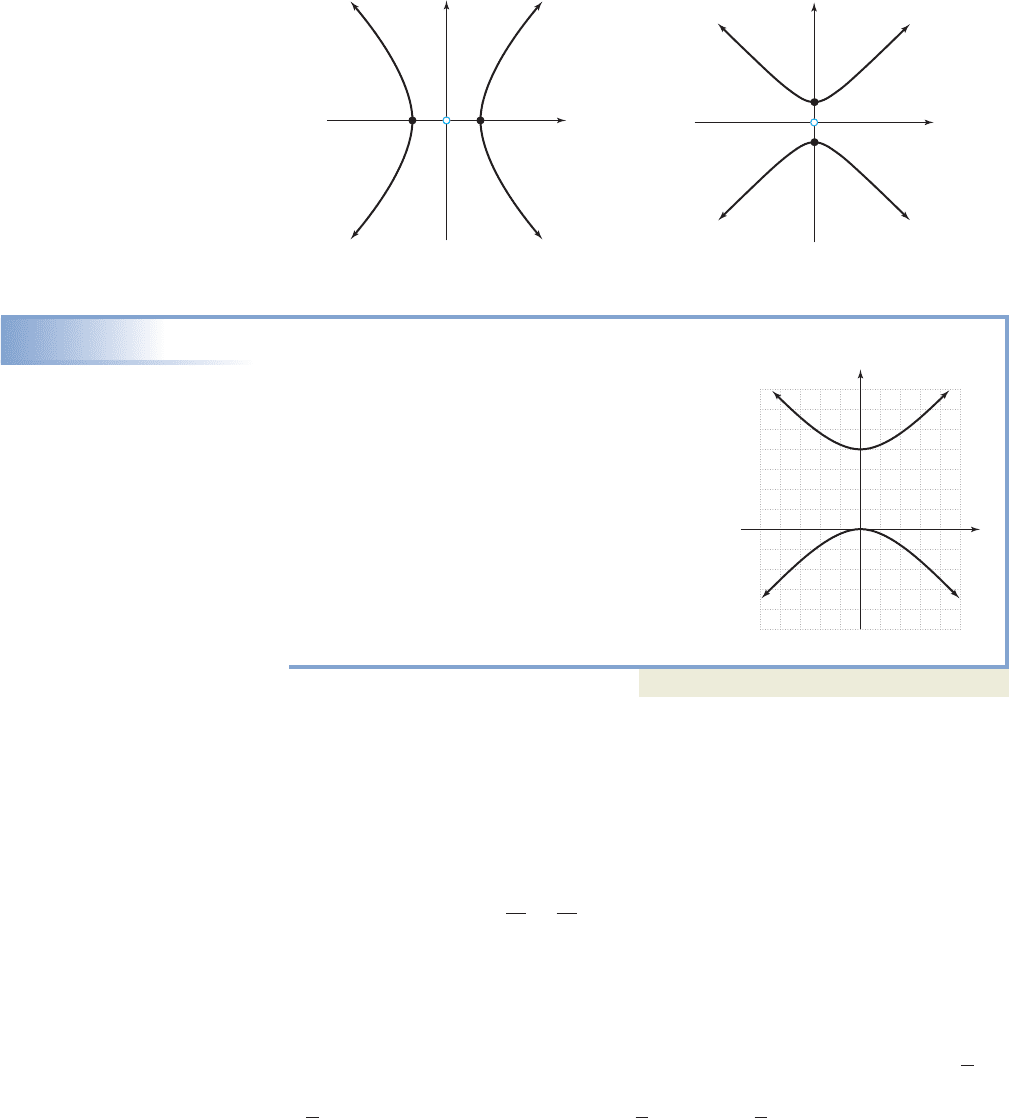
942 CHAPTER 10 Analytic Geometry and the Conic Sections 10-24
positive and we subtract the term containing x
2
, the result is a vertical hyperbola
(Figure 10.20).
EXAMPLE 2
Identifying the Axes, Vertices, and Center of a Hyperbola from Its Graph
For the hyperbola shown, state the location of the
vertices and the equation of the transverse axis.
Then identify the location of the center and the
equation of the conjugate axis.
Solution
By inspection we locate the vertices at (0, 0) and
(0, 4). The equation of the transverse axis is
The center is halfway between the vertices
at (0, 2), meaning the equation of the conjugate
axis is
Now try Exercises 23 through 26
Standard Form
As with the ellipse, the polynomial form of the equation is helpful for identifying
hyperbolas, but not very helpful when it comes to graphing a hyperbola (since
we still must go through the laborious process of finding additional points).
For graphing, standard form is once again preferred. Consider the hyperbola
from Example 1. To write the equation in standard form, we
divide by 144 and obtain By comparing the standard form to the graph,
we note represents the distance from center to vertices, similar to the way we used
a previously. But since the graph has no y-intercepts, what could represent? The
answer lies in the fact that branches of a hyperbola are asymptotic, meaning they will
approach and become very close to imaginary lines that can be used to sketch the graph.
For a central hyperbola, the slopes of the asymptotic lines are given by the ratios and
with the related equations being and The graph from Example 1
is repeated in Figure 10.21, with the asymptotes drawn. For a clearer understanding of
how the equations for the asymptotes were determined, see Exercise 88.
y
b
a
x.y
b
a
x
b
a
,
b
a
b 3
a 4
x
2
4
2
y
2
3
2
1.
9x
2
16y
2
144
y 2.
x 0.
x
55
5
5
y
x
y
Transverse axis
Conjugate
axis
Vertex
Vertex
Center
Vertical
hyperbola
x
y
Conjugate
axis
Transverse
axis
Horizontal
hyperbola
VertexVertex
Center
Figure 10.20
Figure 10.19
College Algebra & Trignometry—
cob19529_ch10_0941-0953.qxd 12/6/08 12:45 AM Page 942 epg HD 049 :Desktop Folder:Satya 05/12/08:
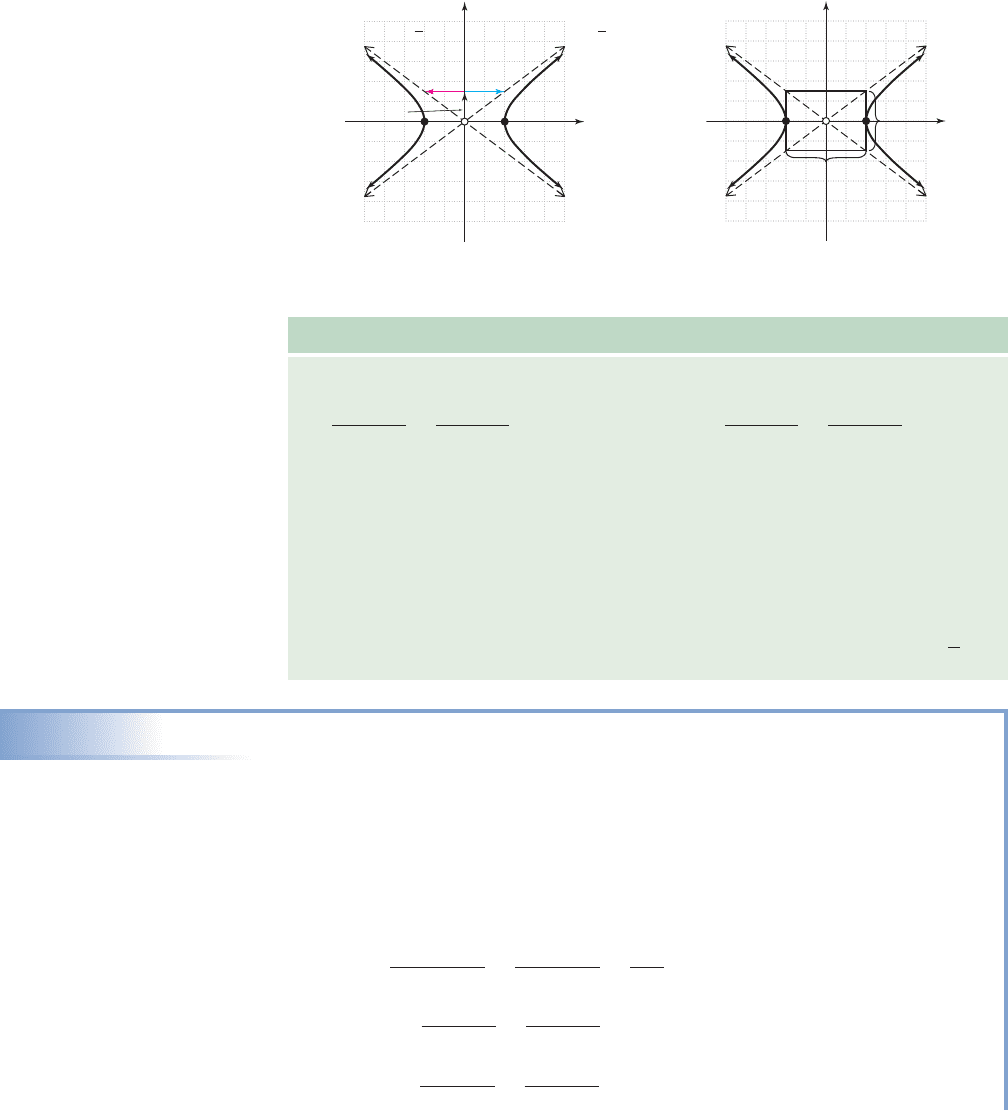
10-25 Section 10.3 The Hyperbola 943
College Algebra & Trignometry—
A second method of drawing the asymptotes involves drawing a central rectan-
gle with dimensions 2a by 2b, as shown in Figure 10.22. The asymptotes will be the
extended diagonals of this rectangle. This brings us to the equation of a hyperbola in
standard form.
The Equation of a Hyperbola in Standard Form
The equation The equation
represents a horizontal hyperbola represents a vertical hyperbola
with center (h, k) with center (h, k)
• transverse axis • transverse axis
• conjugate axis • conjugate axis
• gives the distance from • gives the distance from
center to vertices. center to vertices.
• Asymptotes can be drawn by starting at (h, k) and using slopes
EXAMPLE 3
Graphing a Hyperbola Using Its Equation in Standard Form
Sketch the graph of Label the center, vertices, and
asymptotes.
Solution
Begin by noting a difference of the second-degree terms, with the x
2
-term
occurring first. This means we’ll be graphing a horizontal hyperbola whose center
is at (2, 1). Continue by writing the equation in standard form.
given equation
divide by 144
simplify
write denominators in squared form
1x 22
2
3
2
1y 12
2
4
2
1
1x 22
2
9
1y 12
2
16
1
161x 22
2
144
91y 12
2
144
144
144
161x 22
2
91y 12
2
144
161x 22
2
91y 12
2
144.
m
b
a
.
b
a
y kx h
x hy k
1y k2
2
b
2
1x h2
2
a
2
1
1x h2
2
a
2
1y k2
2
b
2
1
Central rectangle methodSlope method
x
y
(4, 0)
2b
2a
x
y
(0, 0)
(4, 0)
(4, 0)
rise
b 3
Slope m
3
4
3
4
Slope m
run
a 4
Figure 10.22
Figure 10.21
cob19529_ch10_0941-0953.qxd 12/6/08 12:45 AM Page 943 epg HD 049 :Desktop Folder:Satya 05/12/08:
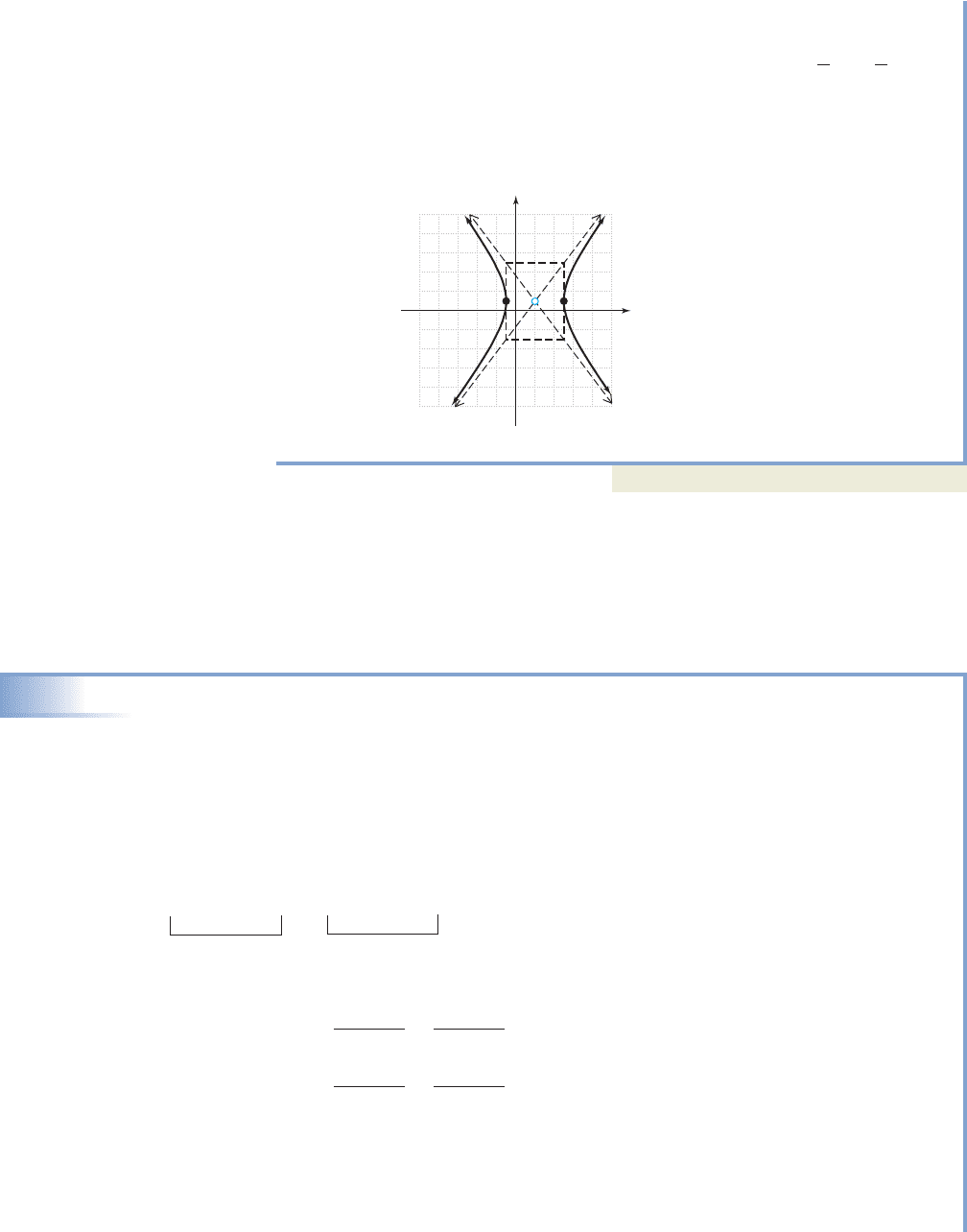
Since the vertices are a horizontal distance of 3 units from the center (2, 1),
giving and . After plotting the center and
vertices, we can begin at the center and count off slopes of or
draw a rectangle centered at (2, 1) with dimensions (horizontal dimension)
by (vertical dimension) to sketch the asymptotes. The complete graph is
shown here.
Now try Exercises 27 through 38
Polynomial Form
If the equation is given as a polynomial in expanded form, complete the square in
x and y, then write the equation in standard form.
EXAMPLE 4
Graphing a Hyperbola by Completing the Square
Graph the equation
Solution
Since the y
2
-term occurs first, we assume the equation represents a vertical hyperbola, but wait
for the factored form to be sure (see Exercise 87).
given
collect like-variable terms; subtract 68
factor out 9 from y-terms and from x-terms
complete the square
adds adds
add to right
factor vertical hyperbola
divide by 9 (standard form)
write denominators in squared form
The center of the hyperbola is with and a transverse axis of . The
vertices are at and and . After plotting the center
and vertices, we draw a rectangle centered at with a horizontal “width” of
and a vertical “length” of to sketch the asymptotes. The completed graph is given in
the figure.
2112 2
2132 612, 32
12, 4212, 3 12S 12, 2212, 3 12
x 2a 3, b 1,12, 32
1y 32
2
1
2
1x 22
2
3
2
1
1y 32
2
1
1x 22
2
9
1
S 9 1y 32
2
11x 22
2
9
81 14 2
1
14 2 49 19 2 81
91y
2
6y 92 11x
2
4x 42 68 81 142
1 9 1y
2
6y
____
2 11x
2
4x
____
268
9 y
2
54y x
2
4x 68
9 y
2
x
2
54y 4x 68 0
9y
2
x
2
54y 4x 68 0.
x
y
(2, 1)
2(3) 6
(5, 1)(1, 1)
m d
m d
Horizontal hyperbola
Center at (2, 1)
Vertices at (1, 1) and (5, 1)
Transverse axis: y 1
Conjugate axis: x 2
Width of rectangle
horizontal dimension and
distance between vertices
2a 2(3) 6
Length of rectangle
(vertical dimension)
2b 2(4) 8
2142 8
2132 6
m
b
a
4
3
,
12 3, 12S 11, 1212 3, 12S 15, 12
a 3
944 CHAPTER 10 Analytic Geometry and the Conic Sections 10-26
College Algebra & Trignometry—
c
c
cc
cob19529_ch10_0941-0953.qxd 12/6/08 12:45 AM Page 944 epg HD 049 :Desktop Folder:Satya 05/12/08:
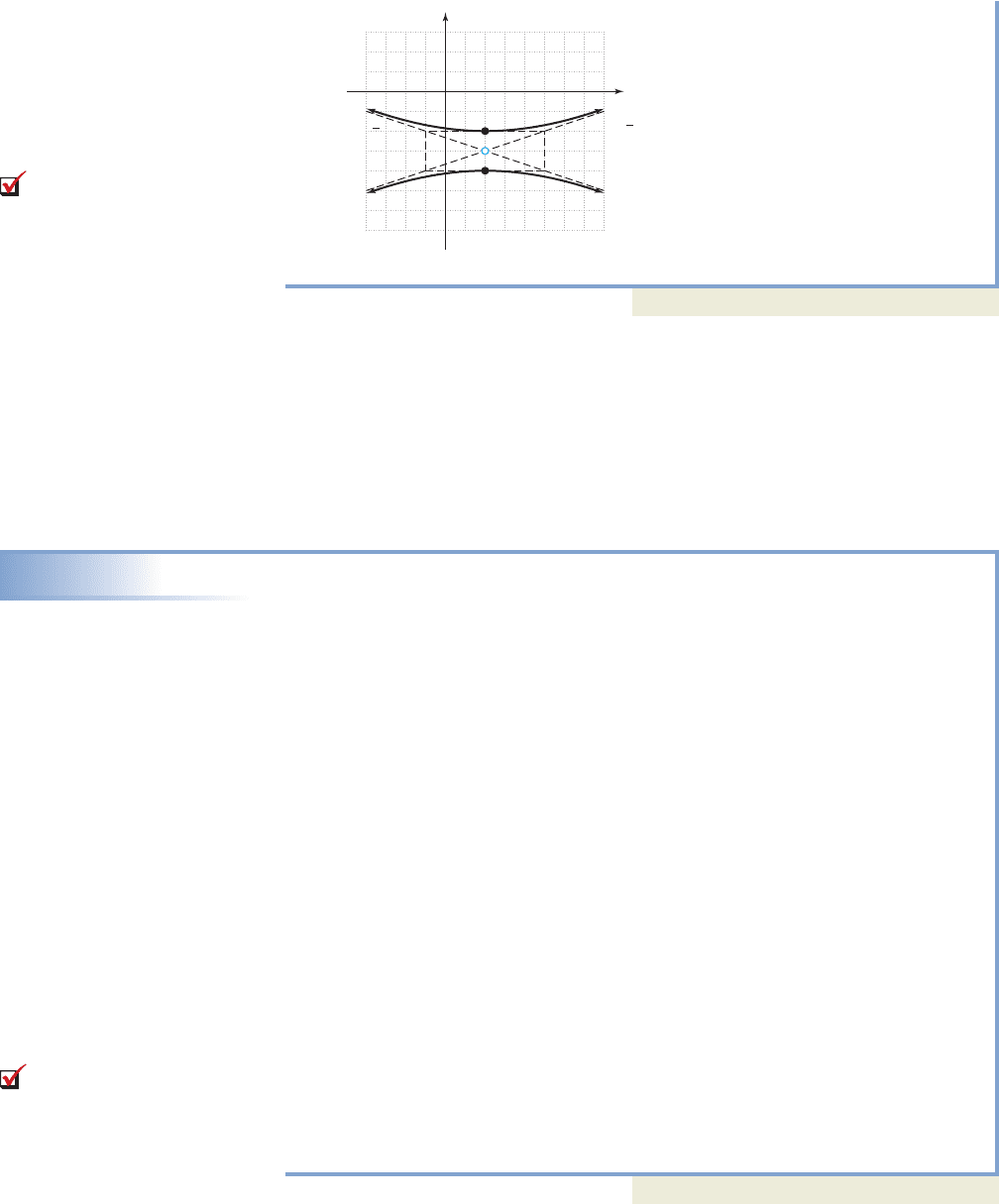
10-27 Section 10.3 The Hyperbola 945
College Algebra & Trignometry—
Now try Exercises 39 through 48
B. Distinguishing between the Equations
of a Circle, Ellipse, and Hyperbola
So far we’ve explored numerous graphs of circles, ellipses, and hyperbolas. In
Example 5 we’ll attempt to identify a given conic section from its equation alone
(without graphing the equation). As you’ve seen, the corresponding equations have
unique characteristics that can help distinguish one from the other.
EXAMPLE 5
Identifying a Conic Section from Its Equation
Identify each equation as that of a circle, ellipse, or hyperbola. Justify your choice
and name the center, but do not draw the graphs.
a. b.
c. d.
e. f.
Solution
a. Writing the equation in factored form gives
Since the equation contains a difference of second-degree terms, it is the
equation of a (vertical) hyperbola. The center is at (0, 0).
b. Rewriting the equation as and dividing by 4 gives
The equation represents a circle of radius 2, with the center at (0, 0).
c. Writing the equation as we note a sum of second-degree
terms with unequal coefficients. The equation is that of an ellipse, with the
center at (0, 0).
d. Rewriting the equation as we note the equation contains a
difference of second-degree terms. The equation represents a central
(horizontal) hyperbola, whose center is at (0, 0).
e. The equation is in factored form and contains a sum of second-degree terms
with unequal coefficients. This is the equation of an ellipse with the center
at .
f. Rewriting the equation as we note a difference of
second-degree terms. The equation represents a horizontal hyperbola with
center
Now try Exercises 49 through 60
C. The Foci of a Hyperbola
Like the ellipse, the foci of a hyperbola play an important part in their application. A long
distance radio navigation system (called LORAN for short), can be used to determine
the location of ships and airplanes and is based on the characteristics of a hyperbola
15, 42.
41x 52
2
91y 42
2
36
12, 32
25x
2
4y
2
100
x
2
25y
2
225
x
2
y
2
4.4x
2
4y
2
16
y
2
9x
2
36 1h 0, k 02.
41x 52
2
36 91y 42
2
31x 22
2
41y 32
2
12
25x
2
100 4y
2
x
2
225 25y
2
4x
2
16 4y
2
y
2
36 9x
2
x
y
(2, 4)
(2, 3)
center
(2, 2)
m
m
Vertical hyperbola
Center at (2, 3)
Vertices at (2, 2) and (2, 4)
Transverse axis: x 2
Conjugate axis: y 3
Width of rectangle
(horizontal dimension)
2a 2(3) 6
Length of rectangle
vertical dimension and
distance between vertices
2b 2(1) 2
1
3
1
3
B. You’ve just learned how
to distinguish between the
equations of a circle, ellipse,
and hyperbola
A. You’ve just learned how
to use the equation of a
hyperbola to graph central
and noncentral hyperbolas
cob19529_ch10_0941-0953.qxd 12/6/08 12:45 AM Page 945 epg HD 049 :Desktop Folder:Satya 05/12/08:
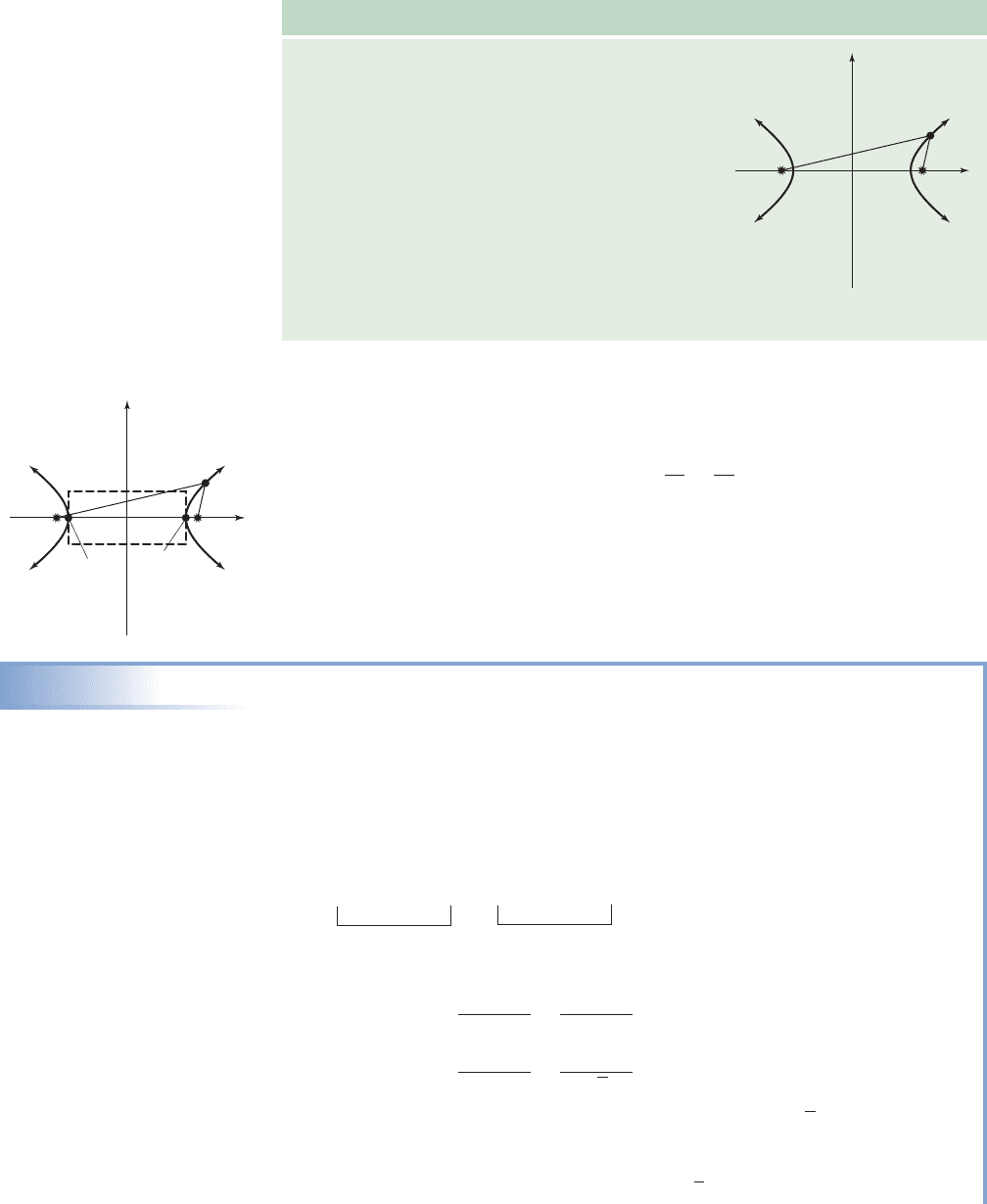
(seeExercises 85 and 86). Hyperbolic mirrors are also used in some telescopes, and have
the property that a beam of light directed at one focus will be reflected to the second
focus. To understand and appreciate these applications, we use the analytic definition of
a hyperbola:
Definition of a Hyperbola
Given two fixed points f
1
and f
2
in a plane, a hyperbola
is the set of all points (x, y) such that the distance from
f
2
to (x, y) subtracted from the distance from f
1
to
(x, y) is a positive constant. In symbols,
The fixed points f
1
and f
2
are called the foci of the
hyperbola, and the points (x, y) are on the graph of
the hyperbola.
As with the analytic definition of the ellipse, it can be shown that the constant k is
again equal to 2a (for horizontal hyperbolas). To find the equation of a hyperbola in
terms of a and b, we use an approach similar to that of the ellipse (see Appendix III),
and the result is identical to that seen earlier: where (see
Figure 10.23).
We now have the ability to find the foci of any hyperbola—and can use this infor-
mation in many significant applications. Since the location of the foci play such an
important role, it is best to remember the relationship as (called the foci
formula for hyperbolas), noting that for a hyperbola, and (also
and ).
EXAMPLE 6
Graphing a Hyperbola and Identifying Its Foci by Completing the Square.
For the hyperbola defined by find the
coordinates of the center, vertices, foci, and the dimensions of the central
rectangle. Then sketch the graph.
Solution
given
group terms; add 200
factor out leading coefficients
complete the square
adds adds
to right-hand side
factored form
divide by 63 and simplify
write denominators in squared form
This is a horizontal hyperbola with and The
center is at (1, 4), with vertices and (4, 4). Using the foci formula
yields showing the foci are and (5, 4)
(4 units from center). The central rectangle is by 2132 6.217
5.29
13, 42c
2
9 7 16,c
2
a
2
b
2
12, 42
b 17
1b
2
72.1a
2
92a 3
1x 12
2
3
2
1y 42
2
1172
2
1
1x 12
2
9
1y 42
2
7
1
7 1x 12
2
91y 42
2
63
9 116 2 1447112 7
71x
2
2x 12 91y
2
8y 162 200 7 11442
7 1x
2
2x
____
2 91y
2
8y
____
2 200
7 x
2
14x 9y
2
72y 200
7 x
2
9y
2
14x 72y 200 0
7x
2
9y
2
14x 72y 200 0,
c
2
7 b
2
c 7 bc
2
7 a
2
c 7 a
c
2
a
2
b
2
b
2
c
2
a
2
x
2
a
2
y
2
b
2
1
d
1
d
2
k, k 7 0
y
x
d
1
d
2
k
k > 0
d
2
d
1
f
1
f
2
(x, y)
946 CHAPTER 10 Analytic Geometry and the Conic Sections 10-28
(a, 0)
(a, 0)
(c, 0)
(c, 0)
y
(x, y)
x
Figure 10.23
c
c
cc
S add 7 11442
College Algebra & Trignometry—
cob19529_ch10_0941-0953.qxd 12/6/08 12:45 AM Page 946 epg HD 049 :Desktop Folder:Satya 05/12/08:

10-29 Section 10.3 The Hyperbola 947
College Algebra & Trignometry—
Drawing the rectangle and sketching the asymptotes to complete the graph, results
in the graph shown.
Now try Exercises 61 through 70
As with the ellipse, if any two of the values for a, b, and c are known, the rela-
tionship between them can be used to construct the equation of the hyperbola.
See Exercises 71 through 78.
D. Applications Involving Foci
Applications involving the foci of a conic section can take many forms. As before,
only partial information about the hyperbola may be available, and we’ll determine
a solution by manipulating a given equation, or constructing an equation from given
facts.
EXAMPLE 7
Applying the Properties of a Hyperbola—The Path of a Comet
Comets with a high velocity cannot be
captured by the Sun’s gravity, and are slung
around the Sun in a hyperbolic path with the
Sun at one focus. If the path illustrated by the
graph shown is modeled by the equation
how close did
the comet get to the Sun? Assume units are in
millions of miles and round to the nearest
million.
Solution
We are essentially asked to find the distance
between a vertex and focus. Begin by writing
the equation in standard form:
given
divide by 846,400
This is a horizontal hyperbola with
and
Use the foci formula to find c
2
and c.
b 46 1b
2
21162.a 20 1a
2
4002
x
2
20
2
y
2
46
2
1
x
2
400
y
2
2116
1
2116x
2
400y
2
846,400
2116x
2
400y
2
846,400,
x
y
(1, 4)
(2, 4)
(3, 4)
(4, 4)
(5, 4)
Horizontal hyperbola
Center at (1, 4)
Vertices at (2, 4) and (4, 4)
Transverse axis: y 4
Conjugate axis: x 1
Location of foci: (3, 4) and (5, 4)
Width of rectangle
horizontal dimension and
distance between vertices
2a 2(3) 6
Length of rectangle
(vertical dimension)
2b 2(√7) ≈ 5.29
C. You’ve just learned
how to locate the foci of a
hyperbola and use the foci
and other features to write its
equation
(0, 0)
y
x
write denominators in
squared form
cob19529_ch10_0941-0953.qxd 12/6/08 12:45 AM Page 947 epg HD 049 :Desktop Folder:Satya 05/12/08:
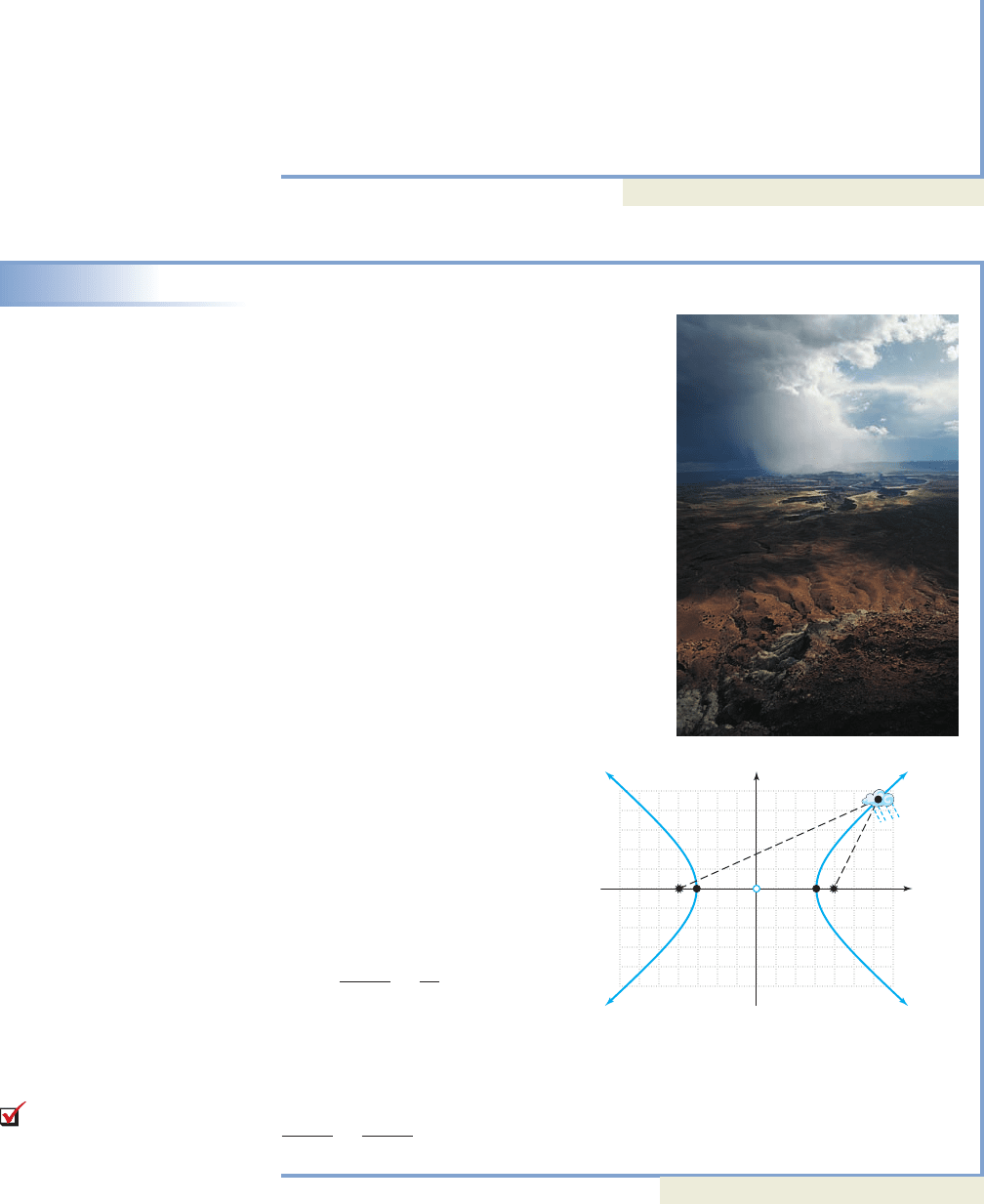
Since and the comet came within million miles of
the Sun.
Now try Exercises 81 through 84
EXAMPLE 8
Applying the Properties of a Hyperbola—The Location of a Storm
Two amateur meteorologists, living 4 km
apart (4000 m), see a storm approaching.
The one farthest from the storm hears a loud
clap of thunder 9 sec after the one nearest.
Assuming the speed of sound is 340 m/sec,
determine an equation that models possible
locations for the storm at this time.
Solution
Let M
1
represent the meteorologist nearest
the storm and M
2
the farthest. Since M
2
heard the thunder 9 sec after M
1
, M
2
must
be m farther away from
the storm S. In other words,
The set of all
points that satisfy this description fit the
definition of a hyperbola, and we’ll use
this fact to develop an equation model for
possible locations of the storm. Let’s
place the information on a coordinate
grid. For convenience, we’ll use
the straight line distance
between M
1
and M
2
as the
x-axis, with the origin an
equal distance from each.
With the constant difference
equal to 3060, we have
from
the definition of a hyperbola,
giving . With
(the distance from
the origin to M
1
or M
2
), we find the value of b using the equation
The equation that models possible locations of the storm is
Now try Exercises 85 and 86
x
2
1530
2
y
2
1288
2
1.
1,659,100 1288
2
.
120002
2
115302
2
c
2
a
2
b
2
: 2000
2
1530
2
b
2
or b
2
c 2000 m
x
2
1530
2
y
2
b
2
1
2a 3060, a 1530
M
2
S
M
1
S
3060.
9
#
340 3060
50 20 30
c
50,a 20
c 50 and c 50
c
2
2516
c
2
400 2116
c
2
a
2
b
2
x
y
1
1
1
2
2
1 2 3 in 1000s23
M
2
M
1
S
948 CHAPTER 10 Analytic Geometry and the Conic Sections 10-30
D. You’ve just learned how
to solve applications involving
foci
College Algebra & Trignometry—
cob19529_ch10_0941-0953.qxd 12/6/08 12:45 AM Page 948 epg HD 049 :Desktop Folder:Satya 05/12/08:
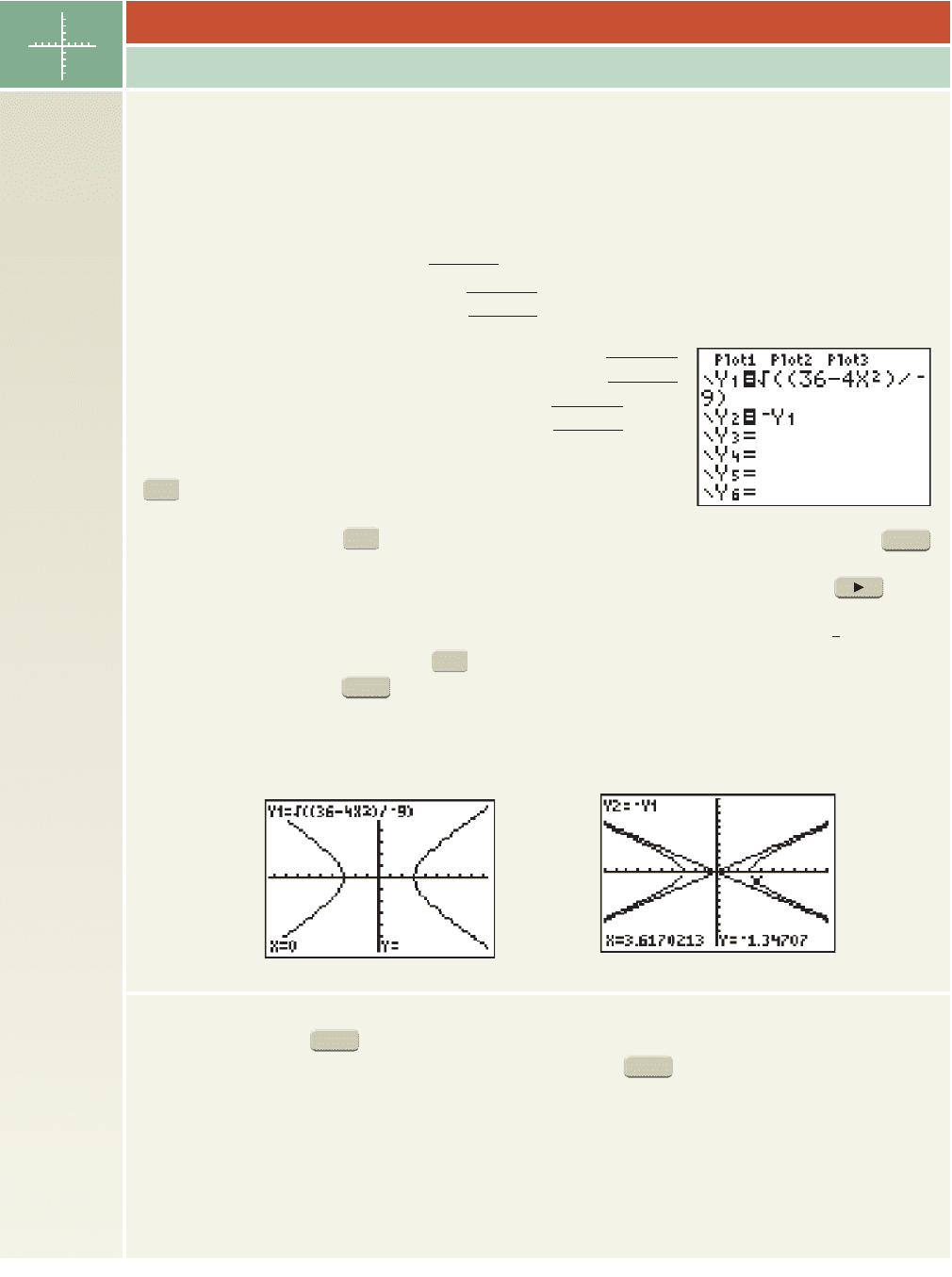
10-31 Section 10.3 The Hyperbola 949
College Algebra & Trignometry—
Studying Hyperbolas
TECHNOLOGY HIGHLIGHT
As with the circle and ellipse, the hyperbola must also be defined in two pieces in order to use a
graphing calculator to study its graph. Consider the relation From our work in this
section, we know this is the equation of a horizontal hyperbola centered at (0, 0). Solving for y gives
original equation
isolate y
2
-term
divide by 9
solve for y
We can again separate this result into two parts:
gives the “upper half” of the hyperbola, and gives
the “lower half.” In Figure 10.24, note the use of parentheses on the
screen to ensure we’re taking the square root of the entire
expression.
Entering these on the screen, graphing them with the window shown, and pressing the
key gives the graph shown in Figure 10.25. Note the location of the cursor at but no y-value is
displayed. This is because the hyperbola is not defined at Press the right arrow key and
walk the cursor to the right until the y-values begin appearing. In fact, they begin to appear at (3, 0),
which is one of the vertices of the hyperbola. We could also graph the asymptotes by
entering the lines as Y
3
and Y
4
on the screen. The resulting graph is shown in Figure 10.26 using
the standard window (the key has been pushed and the down arrow used to highlight Y
2
). Use
these ideas to complete the following exercises.
TRACE
Y =
1y
2
3
x2
x 0.
x 0,
TRACE
Y =
Y =
Y
2
B
36 4x
2
9
Y
1
B
36 4x
2
9
y
B
36 4x
2
9
y
2
36 4x
2
9
9y
2
36 4x
2
4x
2
9y
2
36
4x
2
9y
2
36.
Figure 10.24
Figure 10.25
6
6
10 10
10
10
10 10
Figure 10.26
Exercise 1: Graph the hyperbola using a friendly window. What are the coordinates of
the vertices? Use the feature to find the value(s) of y when Determine (from the graph) the
value(s) of y when , then verify your response using the feature.
Exercise 2: Graph the hyperbola using the standard window. Then determine the
equations of the asymptotes and graph these as well. Why do the asymptotes intersect at the origin?
When will the asymptotes not intersect at the origin?
9x
2
16y
2
144
TABLE
x 4
x 4.
TRACE
25y
2
4x
2
100
cob19529_ch10_0941-0953.qxd 12/6/08 12:45 AM Page 949 epg HD 049 :Desktop Folder:Satya 05/12/08:
